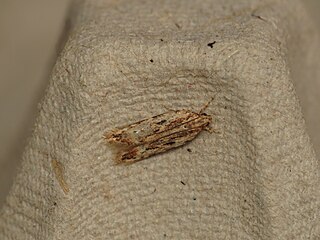
Eutorna tricasis is a moth of the family Depressariidae. It is found in Australia, where it has been recorded from the eastern part of the country.
Ardozyga odorifera is a species of moth in the family Gelechiidae. It was described by Edward Meyrick in 1904. It is found in Australia, where it has been recorded from New South Wales and Queensland.

Ardozyga sisyraea is a species of moth in the family Gelechiidae. It was described by Edward Meyrick in 1904. It is found in Australia, where it has been recorded from Victoria.
Recurvaria saxea is a moth of the family Gelechiidae. It is found in Brazil (Para).
Gelechia frequens is a moth of the family Gelechiidae. It is found in Australia, where it has been recorded from Queensland.
Epimimastis tegminata is a moth in the family Gelechiidae. It was described by Edward Meyrick in 1916. It is found in Australia, where it has been recorded from Queensland.
Battaristis ichnota is a moth of the family Gelechiidae. It was described by Edward Meyrick in 1914. It is found in Guyana.
Compsolechia eurygypsa is a moth of the family Gelechiidae. It was described by Edward Meyrick in 1922. It is found in Peru.
Nephantis serinopa is the only species within the genus Nephantis. N. serinopa is found in Sri Lanka.
Sarisophora cyclonitis is a moth in the family Lecithoceridae. It was described by Edward Meyrick in 1904. It is found in Australia, where it has been recorded from Queensland.
Eutorna epicnephes is a moth in the family Depressariidae. It was described by Edward Meyrick in 1906. It is found in Australia, where it has been recorded from Victoria, New South Wales and Queensland.
Eutorna eurygramma is a moth in the family Depressariidae. It was described by Edward Meyrick in 1906. It is found in Australia, where it has been recorded from Victoria, New South Wales and Tasmania.
Eutorna intonsa is a moth in the family Depressariidae. It was described by Edward Meyrick in 1906. It is found in Australia, where it has been recorded from Victoria, New South Wales and Tasmania.
Eutorna leptographa is a moth in the family Depressariidae. It was described by Edward Meyrick in 1906. It is found in Australia, where it has been recorded from Tasmania.
Eutorna pabulicola is a moth in the family Depressariidae. It was described by Edward Meyrick in 1906. It is found in Australia, where it has been recorded from Queensland and New South Wales.
Eutorna caryochroa is a species of moth in the family Depressariidae. It was described by Edward Meyrick in 1889. It is endemic to New Zealand.
Eutorna generalis is a moth in the family Depressariidae. It was described by Edward Meyrick in 1921. It is found on Java and in Australia.
Eutorna insidiosa is a moth in the family Depressariidae. It was described by Edward Meyrick in 1910. It is found in India (Assam).
Eutorna rubida is a moth in the family Depressariidae. It was described by Alfred Jefferis Turner in 1919. It is found in Australia, where it has been recorded from Victoria.
Phylomictis sarcinopa is a moth in the family Depressariidae. It was described by Edward Meyrick in 1920. It is found in Australia, where it has been recorded from Queensland.

